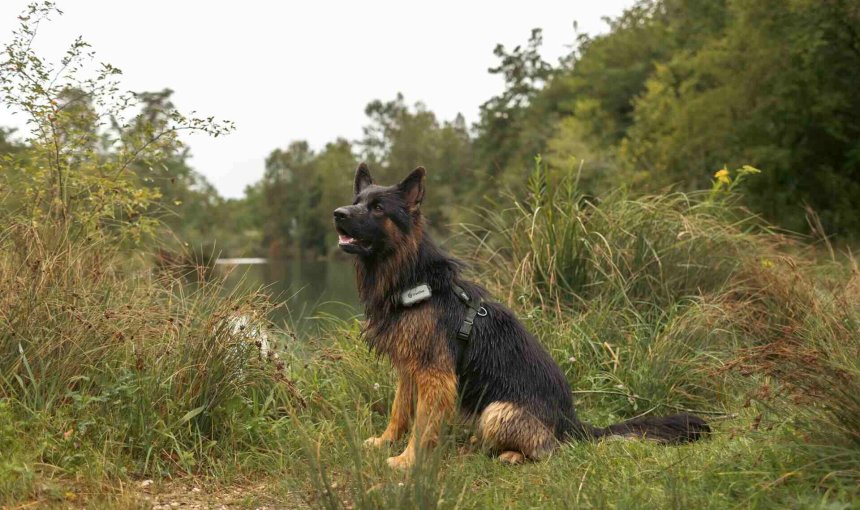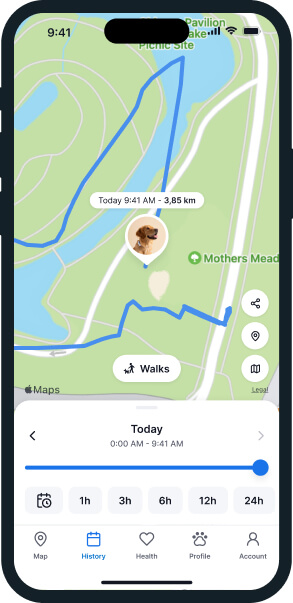How To Get Rid Of Mites On Dogs – For Good
On the bright side, mites on dogs don't pose a big health risk. On the not so bright side...itching, hair loss, and allergies. So here's how to get rid of these pesky critters on your dog - for good.

When you think of pesky critters that infect your buddy’s skin and fur, you might think first of ticks – and you wouldn’t be the only one. But mites on dogs can be as big (and annoying) a problem. Even worse, some species of mites can transfer from dogs to humans. So in this post, we’re going to cover all the ways you can protect your buddy (and yourself) from a mite infestation – including figuring out where your dog’s running into mites in the first place. Let’s get started.

Always know your buddy is healthy & safe
Read moreWhat exactly are mites?
Mites are eight-legged parasites. Which, technically, makes them members of the spider family – in case you weren’t creeped out enough! These little pests are tiny, approximately 1-2 millimeters in size – and their larvae (which like to bite in your dog’s skin) are only around 0.3 millimeters in size.
Unlike ticks, mites don’t feed on blood. Rather, they prefer feeding on your poor dog’s skin tissue and lymphatic secretions. Mites can technically infect any mammal as a host – meaning you, a human, count as a “host” as well! Thankfully, unlike other, more dangerous parasites like fleas, mites don’t tend to transmit any harmful diseases.
At the same time, dealing with grass mites on dogs can be unpleasant, even painful for your poor buddy. The resulting itching and discomfort just isn’t worth the trouble. And since grass mites live in colonies, your dog might pick up several at a time.
Where is my dog running into mites?
Grass mites, for example, like to hang outdoors between April and October. (Aka, peak season for going outdoors with your dog for a hike, run, or camp out in nature.) Though these parasites can also be active earlier or later in the year, if it’s warm enough for them to survive.
Unfortunately, as soon as you’re out and about with your buddy, there’s always the risk they might be infested with grass mites. These little critters like to hang out on dry meadows on warm or hot days. The lay their larvae in grass, where – upon hatching – they wait for your dog to brush past them. Here’s where grass mite larvae end up latching onto your dog’s skin and feeding from them.
🪳Here are some common areas your dog might run into mites:
- Grassy areas, fields, playgrounds, and parks nearby – especially those with tall grass.
- Forests and woodlands where you two might go for a walk, hike, or run
- Your backyard or garden – or those of your neighbors’
- Any nearby sandy or rocky areas, where certain species of mites tend to live
- Indoors, lurking in your bedding and furniture, including carpets and other humid environments where they feed on skin flakes and other organic material. (Watch out for your basements, bathrooms, and laundry rooms in particular.)
- Facilities housing multiple pets, like kennels, shelter, or even grooming facilities – where some mites can spread from pet to pet.

Follow your dog anywhere
Get real-time location information, wherever they go. And find out when they try to make an escape, or just when they go somewhere they shouldn’t, with Virtual Fences.
What are some signs of mites on dogs?
Every dog reacts a bit differently to mites – but it’s most likely they’ll experience some intense itching to begin with. (Though not necessarily always.) Which, with time, can lead to:
- Hair loss from excessive scratching,
- Inflamed, reddened skin,
- Excessive licking (and possible hair loss) around the legs, paws, and belly (all risky spots that mites like to latch on to)
- Scabs or crusty skin
- Dry, flaky skin that resembles dandruff
- Bumps or hives in your dog’s skin
- Restlessness or irritability
- Shaking their ears or head to relieve any discomfort
- Rubbing their face on or scooting their butt across the floor
In more serious cases, your dog might develop an allergic reaction to mite bites. These can worsen any itching and inflammation and might need immediate medical care. In other cases, if you aren’t able to spot a mite bite on your dog, it might worsen the infestation – or open up your dog’s risk for secondary bacterial or even viral infections.
What types of mites tend to infect dogs?
Not all mite species like to feed on dogs, but here are some that do:
- Scabies mites, which can also infect humans and lead to sarcoptic mange in dogs. (Since they can also transfer across animals.)
- Grass mites,
- Demodex mites,
- Harvest mites, also known as Chiggers,
- Ear mites, whose bites can lead to a foul odor around your dog’s ears
- Walking dandruff mites
How can I figure out if my dog has mites?
Now sadly (and scarily!), not every dog infested with mites might experience intense itching or scratching. In fact, if the infestation starts off on the lower side, it’s possible you might miss it entirely. Rather, it’s a good idea to:
- Brush your dog’s coat in the direction of their hair (ideally, on the regular)
- Tap the comb or brush over a white cloth to make the pests drop on to it.
- Mites are more likely to resemble small reddish dots on the cloth.
⚠️ Small brown dots are most likely fleas – in which case, you’re best off rushing your dog to the vet, since fleas can transmit harmful diseases!
How to get rid of mites on dogs (and prevent them from coming back)
Now while mites on dogs aren’t a serious health issue by themselves, it can lead to worse outcomes down the line – especially if your buddy gets a secondary infection. So if you do notice mites, mite bites, or just your dog scratching themselves more than usual, it’s usually a combination of medical treatment and a few lifestyle changes that can help.
Medical treatment
If you have multiple dogs at home, bring them all over to your vet for treatment. Your vet might begin by thoroughly examining them from nose to tail to determine how bad the infection is overall. They might also take a skin scrape to examine under a microscope to figure out the type of pest and what can help against it.
Go prepared to answer questions like:
- When did your dog’s symptoms first appear? Has your dog had them before?
- Did you make any changes to your dog’s food, outdoor privileges or other routines recently? (Other factors like stress, anxiety, or even food allergies can also trigger itching in dogs.)
- Is your dog primarily an indoor or outdoor dog? How often do they head outdoors?
Then, depending on the case, your vet might prescribe your dog:
- Anti-inflammatory ointments that can help reduce itching and inflammation,
- Medicated shampoos that can help kill mites,
- Spot-on treatments,
- Special anti-mite sprays,
- Oral medication, which can help treat mange caused by Sarcoptic or Demodex mites.
- Antibiotics, if your dog is dealing with a secondary infection,
- Ear drops, in case your dog’s ears have been infected
- A year-round flea and tick preventive that can also keep other pests away
In all cases, make sure to follow your vet’s instructions over the full course of treatment (whether that’s over a couple of days or even weeks – and yes, even if your dog seems to be getting better right away.) Also, avoid using any products on your dog that were designed for humans. They’re more likely to be toxic to animals and may worsen the problem.
Do a deep clean of your indoor space
Once you’ve got your medical treatment at hand, make sure to thoroughly clean and disinfect your indoor space from top to bottom – to prevent your dog from spreading its mites elsewhere. This includes:
- Their sleeping area, including any blankets or pillows they like
- Any other surfaces, like couches, rugs, mats, and cushions, they like to sit on
- Food and water bowls
- Toys
- Grooming tools
- Anywhere else around your house your dog likes to spend most of their time
Make sure to wash any clothes, toys, and bedding at a temperature of at least 60 °C/140 °F so that the pests don’t have a chance to come back. For other types of indoor mites, consider using a dehumidifier to lower the humidity indoors.
Don’t skip out on regular grooming
Which can help you pick up on any weird bumps, lesions, bites, patches of missing fur, or even pests in your dog’s fur – while preventing it from matting and tangling. (All of which can attract pests.) Just make sure to use separate grooming tools if you have multiple dogs at home. Also, be sure to follow your vet’s instructions regarding what kind of shampoos to use if you’re dealing with a case of mites.
Watch out for tall grass
In the warmer months, it can be difficult to keep your dog 100% mite-free. Grass mites, for example, lurk pretty much everywhere – especially in high meadows where you and your buddy likely go for on your walks together.
🌿 Which is why it’s a good idea to watch out for areas with tall grass. Including your own lawn and backyard, where it’s a good idea to mow the grass on the regular to prevent pests from gathering. Also watch out for parks with short grass, which have a lower risk of your buddy encountering grass mites. Wash your buddy’s paws and fur thoroughly after a walk outdoors to get rid of any pests.
Figure out where your dog likes to spend most of their time
Whether it’s in your backyard or your neighbors’ – or that kind family down the block that’s just so generous with the treats – your dog has their favorite spots around town. Which may or may not be mite-prone zones that they bring home to you, your couch, your bed, and just about anywhere else. Even your indoor dog that only ventures out with you for walks can run into mites from parks, woodland, hiking trails, or any grassy spot outdoors. (Not to mention from other pets.)
💡 So imagine being able to identify these spots right away – and take precautions much in advance? It’s where a dog GPS tracker can be a lifesaver. From your app, just check your buddy’s Heat Map and Location History:

🐶 And figure out with just a glance at your phone where your dog’s coming home extra-itchy from. Which could be:
- That patch of woodland by your property
- Your neighbors’ open fields and farmlands
- Your own backyard or a neighbors’ garden
⚠️ Where your buddy isn’t just at risk for running into mites – but also harmful chemicals and even more dangerous pests, like fleas and ticks, which can transmit harmful diseases. (Also to humans.)



